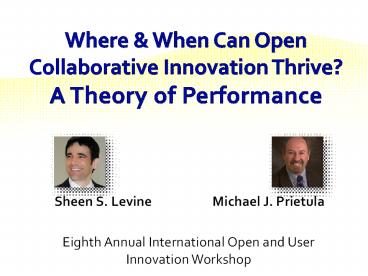Open Collective Innovation - PowerPoint PPT Presentation
Title: Open Collective Innovation
1
Where When Can Open Collaborative Innovation
Thrive? A Theory of Performance
Sheen S. Levine Michael J. Prietula
Eighth Annual International Open and User
Innovation Workshop
2
Characteristics of Phenomenon
Open source software ? ? ? ?
Wikipedia ? ? ? ?
File sharing ? ? ? ?
User forums ? ? ? ?
1 von Krogh von Hippel 2003 3 Shah 2005
5 von Krogh, Spaeth Lakhani 20032 Lee
Cole 2003 4 Mockus, Fielding Herbsleb 2005
6 Lakhani von Hippel 2003
3
Questions about Performance
- Open collaborative innovation differs from
firm-based innovation - (Lee Cole 2003 von Hippel von Krogh 2003)
- How it survives despite massive
free-riding/non-contributing users? - When expands beyond software? In which
environments can it thrive? - How to design open innovation systems?
What affects performance?
4
A General Model of Performance
- Propose a general model of performance based
- on
- Inductive fieldwork in a non-software setting
- Deductive agent-based simulation to generate
propositions - Complements literature on
- Motivation
- (Roberts, Hann Slaughter Shah 2006 von Hippel
von Krogh 2003) - Organization
- (O'Mahony Ferraro 2007 von Krogh, Spaeth
Lakhani 2003)
5
The ModelGoods, Behavior, Needs
6
GoodsHow rival?
BehaviorHow cooperative are participants?
NeedsHow similar or dissimilar?
7
How Rival are the Goods?
- To what extent does ones consumption of the good
interfere with anothers consumption of the same
good
More rival Less rival
Food Clothes Housing Hardware TV broadcast Road Public safety Software
8
How Cooperative are Participants?
- Empirically, human population composed of
individuals with different inclinations (or
strategies) for cooperation - (Kurzban Hauser, 2005)
Remaining 14 are inconsistent
9
How Cooperative are Participants? MASTER
- Empirically, human population composed of
individuals with different inclinations (or
strategies) for cooperation - (Kurzban Hauser, 2005)
Cooperators Reciprocators Free riders
Contribute to others unconditionally Contribute if others contribute too Do not contribute
13 53 20
Remaining 14 are inconsistent
10
How Similar are the Needs?
- Participants may have a variety of needs or very
similar needs. Their needs can differ or resemble
each other.
Similar Needs Dissimilar Needs
Everybody is looking for the same thing Each is looking for different things
11
The MethodAgents interact exchange
12
Agent-based Model
- Each agent has skills and needs, which rarely
overlap - Searches the network to fulfill needs, subject to
cooperation and rivalry characteristics - If search fails, develops or finds outside
network
PerformanceTo what extent goals are accomplished
through collaboration?
13
Single Agents Algorithm
14
Agents Interact Throughout
15
Network of Exchange Interactions
16
What Affects Performance?The Impact of
Cooperation
17
Cooperators Matters
18
How Cooperation Matters?
- Cooperators improve performance
- Decreasing marginal returns from cooperators
19
Reciprocators Matter Greatly
Max
Min
What causes the variance?
20
Performance Robust with Few Cooperators, Many
Reciprocators
Max
Many Reciprocators Few Free-Riders
Min
Many Free-Riders Few Reciprocators
21
Kurzban-Hauser Ratio
Many Reciprocators Few Free-Riders
Many Free-Riders Few Reciprocators
22
How Cooperation Matters?
- Cooperators improve performance
- Decreasing marginal returns from cooperators
- Reciprocators substitute cooperators
- Free riders matter little
23
What Affects Performance?The Impact of Rivalry
and Needs
24
Need Similarity Matters
Kurzban-Houser
25
How Rivalry Needs Matter?
- Rivalry decreases performance
- Rivalry interacts with need similarity
26
What does it Mean?Implications
27
Rivalry Needs Interact to Affect Performance
Performance
Similarity in Needs
Rivalry
28
- Rivalry has non-linear effect on performance
- RivalryNeeds compensatory effect
29
Implications to Practice
- Goods
- Low rivalry produces higher performance, but...
- When needs are dissimilar, high performance
possible even with high rivalry - Cooperation
- Cooperators are important, not very important
Good performance even with tiny core - Reciprocators are underappreciated majority
- Free-riders matter little in realistic settings
30
Implications
- Needs
- Dissimilar needs are an advantage diversity is
valuable - Yet, even similar needs can be satisfied in most
cases
31
Propositions about Performance
- How it survives despite massive
free-riding/non-contributing users? - Free riders matter only in the extreme
- In which environments can it succeed? How to
design open innovation systems? - Near non-rival goods, diversity of participant
needs, many cooperators or reciprocators - If conditions are less than ideal...
- Some elements can compensate for others!
32
Tack
Tak
33
Cooperation Needs Interact































